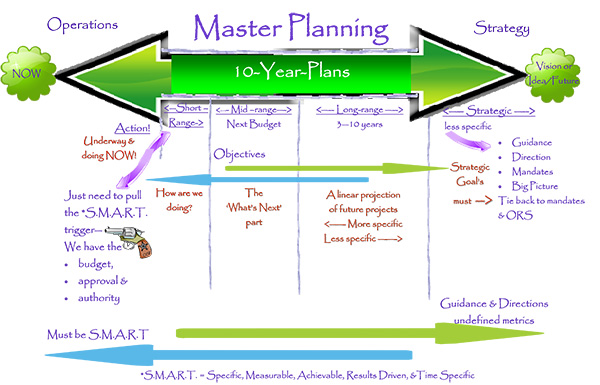By Mark Wallace
Fire department master planning is the compilation of a department’s operational plans (i.e., action plans and short-, medium-, and long-range plans) as well as its strategic plans; each is a necessary component of the master plan.
Fire department master planning differs from community master or comprehensive planning. Each type of operational plan is defined differently in the fire department model than the same-named models associated with for-profit business plans. The major difference is the time horizon of each type of plan. Operational plans are SMART:
- Specific.
- Measurable.
- Achievable.
- Results/outcomes are defined.
- Time-limited.
(Click on the model below to enlarge.)
The Planning Continuum
Each type of plan is connected to the others, also known as the “planning continuum.” At one end of the continuum are the action plans. At the other end is the strategic plan. The whole can now be considered a fire department master plan.
Action plans. These are plans and projects that are in the process of being implemented and completed. They have been funded in the current budget, and work is underway to complete the project according to the defined plan.
Short-range plans. These plans have been funded in the approved budget, but they have not been started. The project has been specifically designed or may still be in the specification or design portion of the plan, but the implementation, contracts, or purchase orders for the project work have not been issued. No further approval is required of short-range plans; all you have to do is “pull the trigger” to set this plan in motion when a department is ready to implement it; only then does it become an action plan.
Mid-range plans. These are operational plans that are not currently funded. However, they must be funded and accomplished as soon as possible. Mid-range plans will be proposed for the coming budget, and those budgets must be decided on by the majority of the elected officials. Most likely, you will know what information and level of detail elected officials will need to approve a proposed plan. And, you should be reasonably sure how they will vote on your proposed plan or project. Once a mid-range plan is approved in a subsequent budget, it becomes a short-range plan. You must add any additional specifications, contracts, requests for proposals, and/or purchase requisitions to the mid-range plan so that it is ready and waiting to be funded in the next budget and implemented as an action plan.
Long-range plans. These plans are typically a linear progression of capital projects that will be proposed to a new yet unknown board or council of elected officials. Long-range plans are the link in the continuum to the department’s strategic plan. Long-range plans are still operational plans. Specific projects such as fire station construction or replacing a fire apparatus during a scheduled or specific coming year are long-range plans. These long-range plans may anticipate other project needs many years into the future—even 20 years or more! The exact year that operational plans should be considered long-range plans varies and is based on local election schedules and term limitations; they represent more than just a calendar of events. The timing, sequence, scope, and conditions surrounding the plans can change just enough in the future to alter them. Long-range plans will eventually become mid-range plans when are close to being approved for future budgets.
Many departments have considered and even named their long-range operational plans as their strategic plans. However, long-range plans can be thought of as the “bridge” between the department’s operational plans and its strategic plan. The farther away chronologically a specific project is in the linear progression of projects, the more “strategic” the project seems.
Strategic plans. These plans are not SMART; they provide guidance and direction for an organization. Strategic plans establish the foundations of a department by defining its values, vision, mandates, mission, philosophy, and strategic issues. They identify strategies to help organization reach its future goals. The strategic plan must be linked to all operational plans and should guide and direct the development and completion of these plans.
This article is just a small sample of information that every current and aspiring chief must know today. For more details, watch for the release of the 7th edition of the Fire Chiefs Handbook.
 Mark Wallace (MPA, EFO, CFO, FIFireE) is the author of Fire Department Strategic Planning: Creating Future Excellence. He is the former State Fire Marshal of Oregon and a former chief in Colorado and Texas. He currently operates Fireeagle Consulting (www.fireeagleconsulting.com). He wrote the planning chapter in the 7th edition Fire Chief’s Handbook, which was released in fall 2014.
Mark Wallace (MPA, EFO, CFO, FIFireE) is the author of Fire Department Strategic Planning: Creating Future Excellence. He is the former State Fire Marshal of Oregon and a former chief in Colorado and Texas. He currently operates Fireeagle Consulting (www.fireeagleconsulting.com). He wrote the planning chapter in the 7th edition Fire Chief’s Handbook, which was released in fall 2014.



